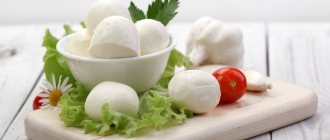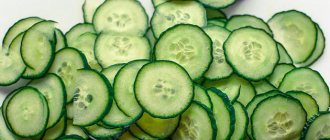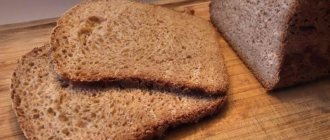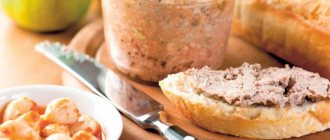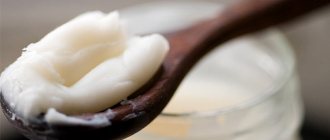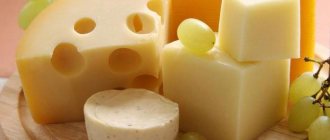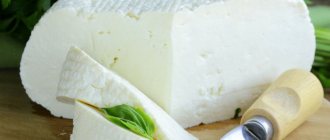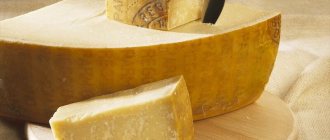Mozzarella is an Italian cheese prepared according to a classic recipe. It belongs to the soft varieties that are kept in brine.
To produce the product using Italian technology, they use milk from black buffaloes. Cottage cheese is obtained from it using two important components, the first is thermophilic leaven, the second is rennet. The classic appearance of the original cheese has a rounded outline, similar in shape to a ball or a chicken egg. There are other smaller varieties in the form of cherry-sized balls - chilenji. If they are the size of a cherry bone, then they are perlini (pearls).
History of the origin of mozzarella
The origins of mozzarella began during the Renaissance. The cheese was first mentioned in the cookbook of Bartolomeo Scappi, who was considered the best chef of those times. The book was published in 1570 and in it mozzarella appeared as a traditional product of those days, which makes it clear that cheese had an even older origin.
Historical documents already from the 12th century contained prerequisites for the production technology or use of mozzarella. Monks from the monastery of San Lorenzo in Capua treated pilgrims to cheese sandwiches called mozza.
Historians claim that in what is now Italy, mozzarella began to be made back in the 6th century, but from cow’s milk, due to the lack of buffalo populations in those areas. The animals initially took root in the marshy areas of Campania and Lazio, and it was then that the inhabitants of these cities came to the conclusion that dairy products made from buffalo milk were much tastier than meat. It was only in the late 18th century that mozzarella became famous due to the increase in the buffalo population.
According to some sources, cheese was invented completely by accident. The locals of Campania, having no refrigeration systems, left the milk in the cellar and forgot about it. After a while they remembered, but found there already soft cheese in the shape of a ball. Over time, the cheese became popular in other regions of Italy, and today Campania produces good quality mozzarella.
How to make mozzarella
Mozzarella is a soft, white, lightly salted steamed cheese with a pleasant, refined taste and flexible structure. It is covered with a thin crust with an appetizing glossy surface.
Make mozzarella as follows:
- Milk is heated to a temperature of 35 degrees, combined with a special bacterium, and in some cases a rennet element is added.
- Next, the resulting mass is sent for ripening, the time of which depends on the ambient temperature and the natural acidity of the raw material. On average, this takes 30 minutes in the warm season, and 60 in the cold season. An additional 20 minutes are also allocated for the milk mass to thicken.
- Break up the milk clot. The process is divided into 2 stages. Initially, a cross is drawn on the surface and left for 10 minutes, and then the mixture is mixed with a special metal nozzle to the very bottom.
- Small particles will then form and settle to the bottom. They will be ready when the acidity reaches 4.8-4.9 and the curd stretches well.
- The whey is drained. It turns out quite a lot and is usually used in the production of another equally popular Italian cheese - ricotta.
- The cheese curd itself is cut into small pieces using a special machine, and then poured with boiling water and a saturated salt solution.
The finished cheese is transferred to cold water, where it remains until it is sold.
Natural fresh mozzarella is sold in bags along with chilled liquid, a transparent white solution. The cheese can be in the form of a braid or large balls with a diameter of 7-10 cm. The range of consumers of such a product is not as high as that of delicate and soft cheese in brine.
Diet with mozzarella for 10 days
For more intensive weight loss, you can use a ten-day diet based on soft cheese.
The diet is based on the consumption of certain foods for five days, then it is repeated, but ingredients cannot be added or swapped.
| Days | 8:00 | 12:00 | 16:00 | 18:00 |
| 1. | One cucumber, 200 ml milk, 30 g mozzarella | 20 g mozzarella, 4 tomatoes, several sprigs of cilantro | 30 g mozzarella, cucumber | Quarter chicken breast (boiled, steamed) |
| 2. | 20 g mozzarella, 3 jacket potatoes (without salt) | 100 g Chinese cabbage, 7 radishes | 200 ml milk, 30 g mozzarella | 20 g mozzarella, 3 boiled carrots |
| 3. | 150 g stewed chickpeas, 200 ml black tea without sugar | 250 g grilled asparagus, 30 g mozzarella | 30 g mozzarella, cucumber | 100 g lentils, 20 g mozzarella |
| 4. | 200 ml milk, mozzarella salad (15 g) and bell pepper | 100 g boiled cauliflower | A few lettuce leaves, 20 g mozzarella | 150 g boiled veal |
| 5. | 2 tomatoes, 20 g mozzarella, 300 ml 1% kefir | 250 g stewed or baked zucchini, 30 g mozzarella | 2 cucumbers, 15 g mozzarella | 70 g celery, 150 g boiled turkey fillet |
In the process of losing weight, do not forget about physical activity, which is an integral part of any diet. Walking in the fresh air or swimming will help speed up the process of getting rid of extra pounds.
Types of mozzarella
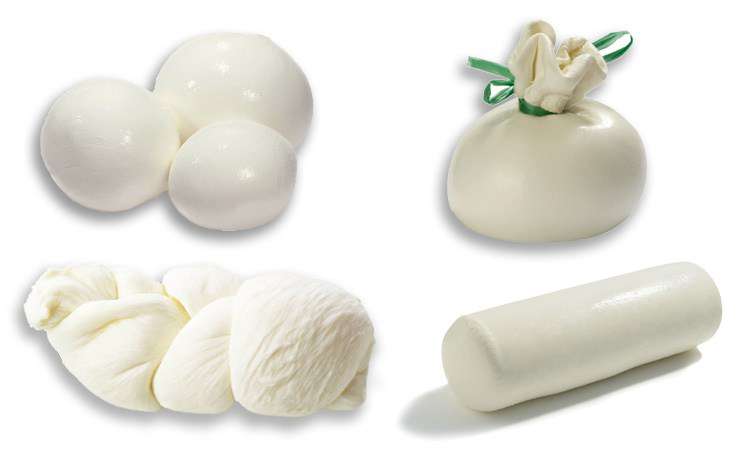
Manufacturers classify mozzarella into several types:
- fresh;
- fresh (from cow's milk);
- stretched (in the form of braids, knots);
- smoked.
Depending on the shape of the final product, mozzarella is divided into:
- bocconcini - egg-sized balls;
- chillenji - circles with large cherries;
- perlini - small pieces;
- Treccia - in the form of a braid.
Some manufacturers develop their own individual twisting method, which is their trademark, feature.
Mozzarella composition
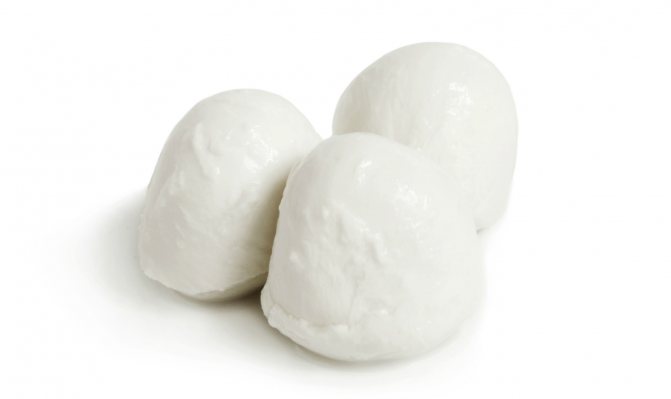
100 grams of mozzarella contain (bju):
- Proteins: 22.17 g;
- Fat: 22.14 g;
- Carbohydrates: 2.4 g;
- Water: 50.01 g;
- Ash: 3.28 g;
- Saturated fatty acids: 13.9 g;
- Monounsaturated fatty acids: 6.573 g;
- Polyunsaturated fatty acids: 0.765 g.
Vitamins:
- Vitamin A: 179 mcg;
- Retinol: 0.174 mg;
- Beta-carotene: 0.057 mg;
- Vitamin B1, thiamine: 0.03 mg;
- Vitamin B2, riboflavin: 0.283 mg;
- Vitamin B4, choline: 15.4 mg;
- Vitamin B5, pantothenic: 0.141 mg;
- Vitamin B6, pyridoxine: 0.037 mg;
- Vitamin B9, folate: 7 mcg;
- Vitamin B12, cobalamin: 2.28 mcg;
- Vitamin D, calciferol: 0.4 mcg;
- Vitamin D3, cholecalciferol: 0.4 mcg;
- Vitamin E, alpha tocopherol, TE: 0.19 mg;
- Vitamin K, phylloquinone: 2.3 mcg;
- Vitamin RR, NE: 0.104 mg.
Macronutrients:
- Potassium, K: 76 mg;
- Calcium, Ca: 505 mg;
- Magnesium, Mg: 20 mg;
- Sodium, Na: 486 mg;
- Sulfur, S: 221.7 mg;
- Phosphorus, P: 354 mg.
Microelements:
- Iron, Fe: 0.44 mg;
- Manganese, Mn: 0.03 mg;
- Copper, Cu: 11 µg;
- Selenium, Se: 17 µg;
- Zinc, Zn: 2.92 mg;
- Cholesterol: 79 mg.
The content of amino acids, polysaccharides and other organic substances expand the range of influence of the product on organ systems and normalize all life processes.
The huge content of calcium, phosphorus and vitamin A in the composition of mozzarella determines the value of this product for baby food, its importance in the menu of pregnant women, nursing mothers, and the elderly.
Mozzarella calories
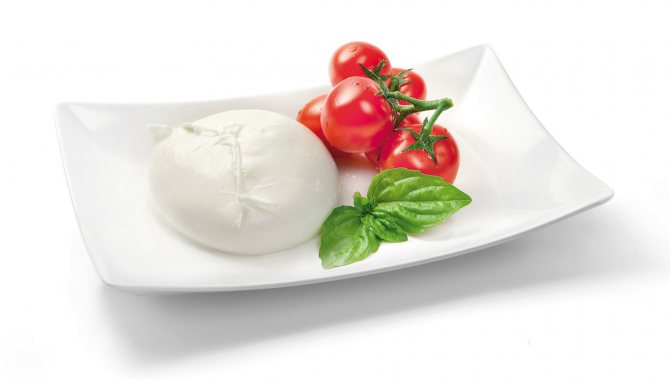
The calorie content of 100 g of mozzarella cheese is about 300 Kcal
, but the indicator may vary depending on the quality of the milk and the processing method. The natural product is a low-calorie cheese, therefore it is recommended by nutritionists to be included in the menu for weight loss.
The nutritional value of mozzarella is that more than 1/5 of the product is protein, which is quite important for people who want to lose weight. The increased fat content of the product should not be taken into account, as it is quickly absorbed by the body and has a positive effect on metabolism.
Mozzarella is included in fasting days and various effective diets. A natural source of protein and a balanced amount of valuable vitamins and minerals impress both nutritionists and people skeptical of any diet.
Three-day cheese diet
By eating mozzarella for three days in combination with other products, you can get rid of one to three kilograms.
To do this, you must adhere to the following power plan:
| Days | 7:00 | 11:00 | 13:00 | 15:00 | 17:00 |
| 1. | 50 ml espresso, 30 g mozzarella | 250 ml green tea, hard-boiled egg | 70 g mozzarella, 250 g turkey fillet | 200 g whole grain cottage cheese | 300 ml 1% kefir |
| 2. | 250 ml green tea (not strong), salad of 30 g mozzarella and one bell pepper | 250 ml green tea, hard-boiled egg | Half boiled chicken breast, 30 g mozzarella, 200 ml mineral water | 2 cucumbers, 100 g mozzarella | 30 g mozzarella, 250 ml low-fat yogurt |
| 3. | 170 g whole grain cottage cheese, 2 large tomatoes | 100 g boiled asparagus, 50 g cheese, 200 ml still mineral water | 200 ml still mineral water | 200 ml still mineral water | One green apple, 50 g cheese |
Note that homemade mozzarella typically contains twice as many calories as store-bought mozzarella.
The benefits of mozzarella
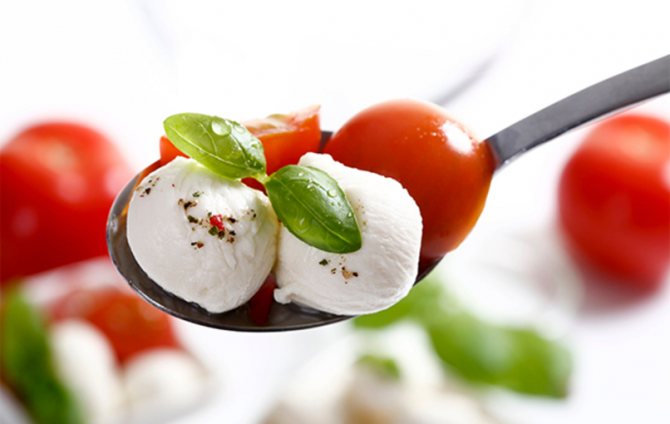
A detailed examination of the composition of mozzarella cheese revealed that the chemical compounds and mineral components found in it benefit the body:
- prevent vitamin deficiency by saturating the body with all the necessary biologically active substances;
- strengthen bone tissue, serve to prevent diseases of the musculoskeletal system;
- increase joint mobility;
- exclude atherosclerosis and many diseases of the heart and blood vessels;
- normalize the digestion process, prevent cancerous tumors of the intestinal tract;
- eliminate bad cholesterol;
- improve the condition of tooth enamel, hair, nails;
- provide the body with energy and endurance;
- increase performance, memory, thinking and attention;
- relieve insomnia and chronic fatigue;
- activate water balance, protect against dehydration;
- support women's health, eliminate inflammation and genitourinary infections;
- normalize metabolism, so that all calories consumed are consumed and not stored on the hips.
The natural product accelerates metabolic processes, which has a positive effect on a person’s well-being, his immunity, energy level, work potential, and positive attitude. Without it, it is impossible to imagine a complete and healthy menu that gives a person the necessary energy for life.
Beneficial features

This product contains a lot of useful substances that have a beneficial effect on the human body:
- B vitamins help normalize the nervous system in moments of psychological instability, stress, and insomnia.
- Retinol is a powerful antioxidant that helps maintain vision, skin condition, and helps reduce inflammation.
- Phosphorus promotes the normal growth of bone and dental tissues of the body and maintains them in a healthy state. Without this component, normal functioning of mental activity is impossible. Also, consuming insufficient amounts of phosphorus can lead to fatigue and weakness, frequent colds, loss of appetite and attention.
- In addition to the fact that calcium helps strengthen bone tissue, it also has a positive effect on blood clotting and the nervous system.
- Sodium is responsible for normalizing water-salt metabolism, participates in the production of gastric juice, has a vasodilating effect and maintains normal acid-base balance.
- The protein contained in cheese supports muscles and replenishes the body's energy reserves.
Regular consumption of this product in reasonable quantities prevents various heart pathologies leading to heart attack or stroke, and also protects against the development of rheumatism, which causes excessive accumulation of uric acid in the joints. Along with this, the product prevents various heart pathologies that can lead to stroke or heart attack.
One of the main and, perhaps, important elements for the human body are proteins and fats obtained from this product. Regular consumption of mozzarella cheese saturates the body with complete protein, prevents the occurrence of hormonal disorders and anemia, improves immunity, and also helps fight pastosity and swelling.
Harm of mozzarella
Many people consider cheese to be an absolutely safe product, but there are a number of contraindications in which consuming mozzarella can cause harm to the body:
- Allergy or intolerance to milk protein.
- Kidney failure, swelling.
- Neurological disorders.
It is not recommended to eat cheese during an exacerbation of diseases of the digestive system: gastritis, pancreatitis, cholecystitis. But during the period of remission, it is useful to eat fresh cheese to diversify the menu and saturate the body with all the necessary substances.
Mozzarella does not contain a lot of salt and other spices, unlike other popular types of cheese. Therefore, the product is approved for hypertensive patients, people suffering from heart disease and digestive system disorders, as well as diabetes.
Mozzarella contains a lot of nutritious and healthy fats, which in small quantities stimulate metabolism and promote weight loss.
Excessive intake of the product can provoke obesity, so nutritionists advise lovers of this type of cheese to switch to a low-fat version.
Improper storage or expired mozzarella can be harmful to the body.
What wine goes with mozzarella?
Mozzarella boasts a soft, completely unsaturated and non-intrusive taste. Therefore, on the one hand, it is recommended to pair it with a white semi-dry wine with a soft, fresh taste, pleasant aroma and light sourness. It is believed that this particular type of cheese perfectly “knows how” to reveal the taste qualities of this drink.
On the other hand, there is a fairly large public that prefers to combine unleavened mozzarella with juicy red wine, including if the cheese goes with ham. Ultimately, the main thing is to enjoy the meal as much as the Queen of England, who is rumored to be served this cheese before every dessert.
Mozzarella in cooking
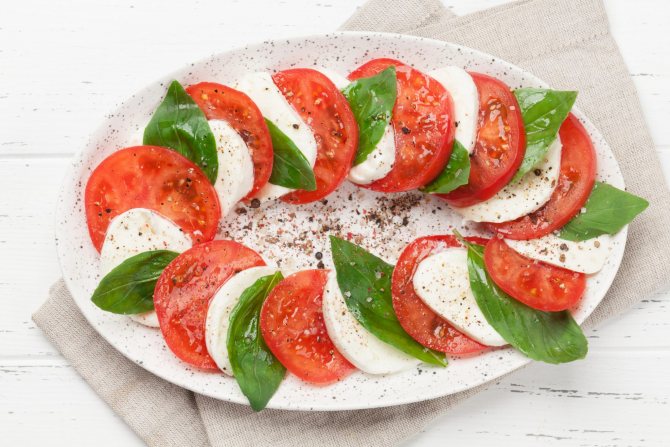
The taste characteristics of mozzarella have made the product popular in cooking. It is used in the preparation of many dishes, especially Italian cuisine. Most of the signature classic dishes of the restaurant world are not complete without this delicate and aromatic cheese.
Culinary experts recommend using mozzarella for:
- cold snacks;
- fresh salads of vegetables and herbs with olives;
- caprese appetizer salad;
- traditional Italian pizza;
- classic closed calzone pizza;
- lasagna, casseroles;
- many vegetable, mushroom and meat dishes;
- food in pots;
- various desserts.
Mozzarella goes well with tomatoes, basil, pepper, and is decorated with herbs, olives, and aromatic spices. It is usually served with white wine PinoGrigio or PinoBianco.
When preparing dishes, it is important to take into account that prolonged heat treatment at high temperatures will dry out the cheese, which will significantly worsen the taste.
How to replace mozzarella
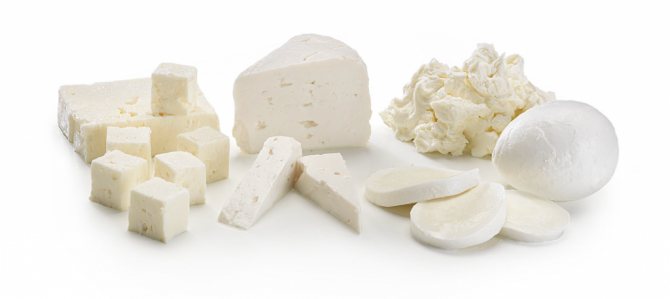
Due to the extraordinary juiciness, delicate taste and aroma of mozzarella, it is difficult to find a similar product with similar parameters. But not every person can afford such a product due to allergies or lack of availability.
Experienced chefs know that mozzarella can be replaced with other equally nutritious products, including:
- feta cheese;
- Suluguni;
- Tilsiter;
- Adyghe cheese;
- feta;
- ricotta.
When choosing a suitable replacement, you should focus on the dish and its taste characteristics. For example, in Caprese salad you can get by with feta cheese, and grease lasagna with feta cheese. Any cheese product is suitable for baking, even Parmesan or Russian cheese.
Finding fresh mozzarella these days is not an easy task. Quite often, products in supermarkets turn out to be far from the original cheese, rich in casein. The reason is incorrect production and storage technology, since real cheese is fresh only for the first day, as well as the use of cow's milk instead of black buffalo milk.
Production technology
The production of Italian mozzarella is as follows:
- Special rennet and thermophilic starter culture are added to fresh black buffalo milk.
- The resulting mixture is heated to curdle the milk.
- Then the mass is infused for at least eight hours, after which it is heated again and separated from the whey.
- The resulting cottage cheese is kneaded well until it forms a stiff dough. To make the surface shiny and smooth, the mass is heated several times during the kneading process.
- The plastic semi-finished product is easily cut into the required pieces. It was previously mentioned that the type of cheese depends on the size of the pieces.
- The chopped product is then dipped into ice-cold salt water.
As a rule, cheese balls are left in the same salty solution and packaged, and braids or too large pieces are vacuum packed without brine.
Is it possible to freeze mozzarella?
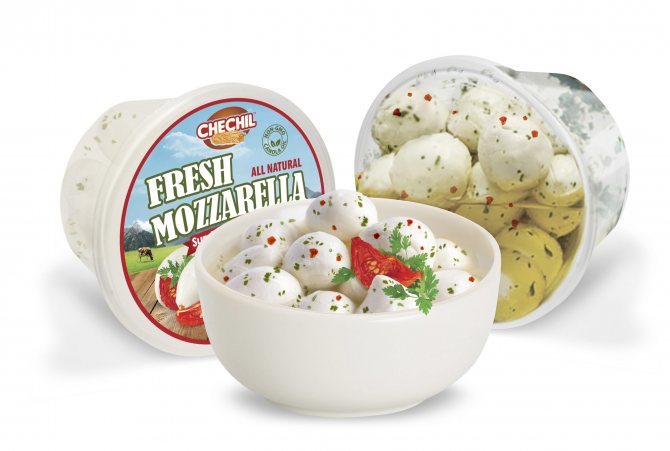
Manufacturers categorically do not recommend freezing mozzarella, since after exposure to low temperatures it will turn into a shapeless curd mass and completely lose its taste. But if a more gentle freezing method is used, a different outcome is possible.
It consists of the following steps:
- Be sure to remove the cheese from its original packaging.
- Place in a special glass container designed for freezing.
- Fill the container with brine from the manufacturer's packaging so that the mozzarella is completely immersed in the liquid. It is worth remembering that when frozen, moisture expands, so there should be free space in the container.
- Seal the container hermetically and place in the freezer.
Under such conditions, the shelf life of mozzarella is extended to 1 month. Defrost the product only in the refrigerator. If you place it immediately in a warm room, there is a high probability of the cheese spoiling. It is worth considering that this freezing system works with a natural and high-quality product, which, unfortunately, is now quite difficult to find in stores. To ensure a longer shelf life, mozzarella is filled with various preservatives and other substances that are harmful to the body and spoil the overall taste of the cheese.
Mozzarella is an appetizing, tender and juicy cheese that does not leave any gourmet indifferent and is a signature ingredient in many dishes. Using a natural product, you can experiment in the kitchen, realizing the most unusual ideas for appetizers, salads, pastas, pizzas and even desserts. The main thing is to study the information about mozzarella in detail and, armed with knowledge, adjust your own nutrition menu, supplementing it with healthy cheese.
Pasteurized milk recipe
Mozzarella is a homemade cheese that is perfect for a holiday table as an appetizer. According to the recipe, which includes the use of pasteurized milk, the resulting cheese has an exquisitely delicate taste.
Composition of ingredients
To prepare a dish from pasteurized milk, you will need the following ingredients:
- pasteurized milk – 300 ml;
- 2.5 ml liquid rennet;
- distilled water – 170 ml;
- citric acid – 10 ml;
- 5-10 g salt.
Step-by-step cooking process
- The first step is to place a large pan of water on the stove and bring it to a temperature of 82 degrees.
- Then you need to add rennet to the liquid and mix well until the component is completely dissolved.
- Next, it’s time to dissolve the citric acid in a separate pan, stirring thoroughly.
- After this, milk should be added to the acid.
- It's time to gradually add water to the milk. At the same time, it will begin to curl.
- Heat the pan with the mixture over low heat to 31 degrees, stir constantly with a spoon or whisk so that the milk does not burn.
- Then you need to combine the milk mixture with water and reduce the heat to low. You need to cook the mixture at low speed until the temperature reaches 40 degrees.
- Remove the pan from the heat and leave to stand for 15 minutes. During this period of time, the curds will separate from the whey.
- The mass must be cut into small cubes using a knife and left to brew in this form for 5-7 minutes.
- Place a colander with gauze inside over a dry bowl and place the mixture there. Leave the mixture in this position for 3-4 hours to drain excess moisture.
- The cottage cheese needs to be salted and the liquid drained again so that the cheese remains as dry as possible.
- It is recommended to pour hot water into a bowl and place the resulting mass in it. At this stage, it is important to work with rubber gloves so as not to burn your hands. After all, you need to squeeze the cottage cheese with your hands, taking it out of the water. Then immerse it back into the hot liquid. This procedure must be done several times, and the cottage cheese must be processed in parts under this ray.
- The cheese is considered ready when, after being taken out of the water, it does not tear in your hands. It should be flexible and have a glossy shine. Then it's time to roll it into a ball.
- The remaining whey should be mixed with salt and ice. It is recommended to cool the mozzarella in this brine.
- For storage, the finished product should be wrapped in cling film or placed in a food container.
What can I add?
Not only liquid rennet can be added; tablets can also be used. For this volume of products you will need ½ tablet of enzyme. Citric acid can be replaced with lemon juice.
How to serve a dish
Cheese balls can be served as an independent dish for lunch or dinner. Mozzarella goes well with a glass of fine dry white wine . To emphasize the taste of the product, it should be seasoned with olive oil and black pepper.
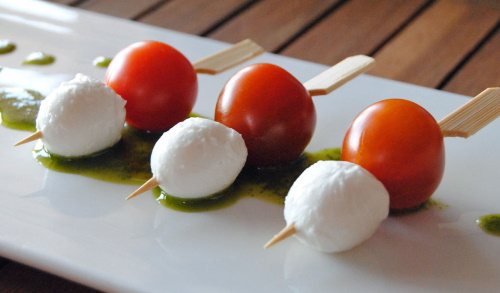
This homemade dish is in harmony with ham, tomatoes, basil and freshly baked bread. The product should also be used as a topping for pizza and one of the main components in salads.
The characteristics of the cheese allow it to be used in the preparation of many dishes:
- fresh cheese should not be stored for more than a month;
- from contact with air, the mass can become weathered in a few hours, and a crust with a yellow tint forms on it;
- It is not recommended to freeze mozzarella in the freezer, since after defrosting the product spreads and acquires an unpleasant consistency;
- cheese can become soft at room temperature in a short period of time; it should be cooled before use, especially if you need to grate it for a dish;
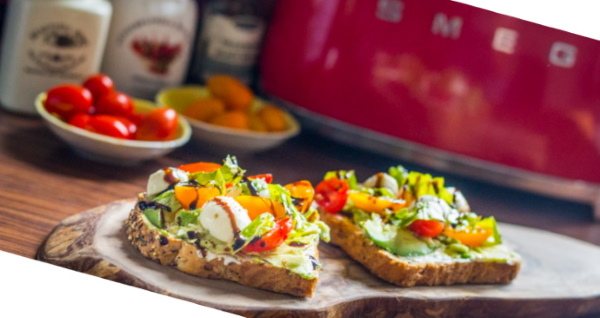
- products are not afraid of low temperatures;
- after adding to a pizza or casserole, the cheese melts perfectly, does not release fat, its viscousness remains even after the dish has cooled;
- mozzarella does not interrupt the flavor notes of other components in culinary experiments.
Among the varieties of Italian cheeses, mozzarella is considered the queen of sandwiches, bruschettas and paninis . If you follow the cooking rules and instructions and do not violate the temperature regime, even home-made cheese will not be inferior in taste and quality to the original product. This unique product is one of the favorite cheeses of many peoples of the world and is used as an ingredient in many different dishes.
5
Author of the publication
offline 1 year
